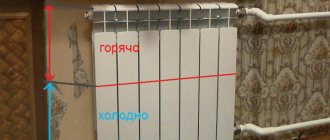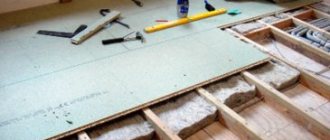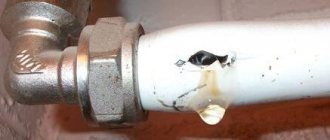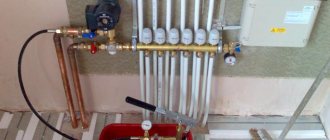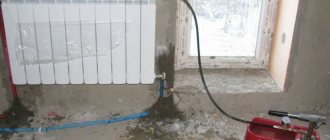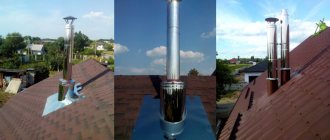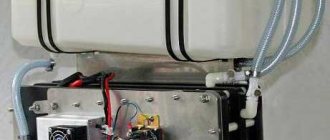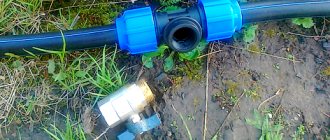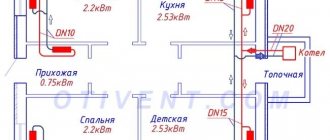Home / Gas boilers
Back
Published: 05/22/2019
Reading time: 2 min
10
32904
Gas boilers are designed to create comfortable living conditions. Double-circuit units provide the living space with heat and hot water at the tap. But it happens that a working boiler does not heat the water well and does not provide the necessary comfort.
The efficiency of the entire heating system depends on how the boiler operates. If there is a problem in the gas boiler itself, this can negatively affect the efficiency of the entire system and cause excessive consumption of energy resources. What happens when the boiler stops heating water? Let's look at the reasons and ways to solve this problem.
- 1 How does a boiler work?
- 2 The boiler does not heat water for heating
- 3 The boiler does not heat water for hot water supply
Boiler malfunctions
Typical problems with the operation of heating equipment:
- malfunction of the built-in pump;
- the heat exchanger is clogged;
- The three-way valve does not work.
If the boiler is working and the radiators are cold, experts recommend, first of all, assessing the technical condition of the main heating element. More specifically, determine whether the circulation pump built into the device is working. This part is an invariable attribute of modern equipment and is designed to increase the efficiency of its operation. Very often, after a long period of inactivity in the summer, the pump can become clogged or become covered with a layer of limescale. As a result, it does not remove the heated coolant from the heat exchanger in a timely manner. The boiler is boiling, but the radiators are cold.
It is strictly prohibited to independently repair such complex equipment as a boiler. In this case, either a specialist from the service center or a repairman with the appropriate certificate or permit is called to your home.
Experts do not recommend using ordinary tap water as a coolant, as it is hard. When the coolant temperature increases, dissolved salts settle on the heat exchanger. As a result, the following problem arises: the boiler is working, but the radiators are barely warm. Scale reduces the thermal conductivity of the heat exchanger, so the water in the circuit does not heat up, although the heating element constantly works with excessive energy consumption. You can fix the problem by changing the coolant and cleaning the heat exchanger. This video will help you understand how to clean the heat exchanger correctly:
A double-circuit boiler heats water, but does not heat the radiators. Here you need to pay attention to the serviceability of the three-way electric valve. It is responsible for switching the bypass from heating circuit maintenance mode to DHW and CO mode.
Before making a heating register with your own hands, familiarize yourself with the technical base.
Why can't antifreeze be used for radiators? The answer is here.
Gas boiler Navien, main faults and their elimination
Do-it-yourself repairs require certain knowledge and skills in working with gas equipment. There is a special manual that describes the main fault codes. There are no repair instructions provided for users. The manufacturer assumes that troubleshooting will be carried out exclusively by service centers.
But many breakdowns can be fixed on your own without wasting time and money on a professional technician. To do this, it is enough to familiarize yourself with the main malfunctions and their elimination.
Navien gas boiler does not start
If the system does not turn on the control panel, then the problem is usually a lack of power from the electrical network. If the power supply is turned off by utilities, you should wait until the supply is restored. To understand how to turn on the equipment, just plug the cord into an outlet.
A common problem is the gas boiler turning on and off frequently. The source of the malfunction is an incorrectly installed circulation pump. The heating often turns off when the temperature range is incorrect. Also, the equipment turns on and off every 5-7 minutes in the absence of a thermostat.
The Navien boiler does not reach the set temperature
The most common malfunction of a Navien gas boiler is that the system does not heat up to the specified parameters. To fix the problem, you need to clean the heat exchanger using household plumbing chemicals or specialized compounds. To do this, the device is dismantled, the selected solution is poured into it, after which the part is thoroughly washed with a large amount of water. If the boiler does not heat hot water, then you can clean the heat exchanger of the DHW circuit in the same way.
The Navien boiler quickly gains and drops temperature
If the Navien gas boiler quickly heats up and cools down, then the fault should be sought in the heating system. You can adjust the pump speed to force fluid movement or remove air pockets.
We recommend: Warm floors in the house - types, advantages
During diagnostics, it is necessary to inspect the filtration system and the lumen of the heat exchanger. You may also need to replace the antifreeze. Spare parts for Navien gas boilers are freely available - they can be ordered online or purchased in a specialized store.
Malfunction of the boiler ventilation system
If you do not use Navien Deluxe floor or wall heating equipment for a long time, a lot of dust accumulates inside, which negatively affects the operation of the fan. To fix the problem, you will need to clean and lubricate the system.
Water oversaturated with oxygen
During natural circulation, water bubbles form, which burst and cause noisy operation of Navien Ice 24 and other models. If you add membranes to the system, the problem will disappear.
Pressure failures
Failures in water pressure of Navien heating devices are usually associated with leaks. The coolant penetrates into all small cracks, which affects the operation of the equipment. Also, the reasons include a malfunction of the three-way valve or secondary heat exchanger.
Problems with the heating circuit
The pump must be selected according to the requirements of the heating circuit.
Malfunctions in the operating mode of the heating circuit are not always associated with a malfunction of the main heating element. If the boiler works, but does not heat the batteries, the reason must be sought in the wiring itself.
List of main heating circuit malfunctions:
- the filter on the return line or the needle tap (Maevsky tap) is clogged;
- insufficient power of the circulation pump;
- the rules for installing a heating circuit with natural circulation have not been followed.
Any of the above problems must be resolved before the start of the heating season. Otherwise, the room may be left without heat for several days, since the repair involves completely draining the coolant.
So, why doesn’t the boiler heat the batteries if everything worked fine over the previous years? The reason is a dirt plug that has formed on the heating circuit filter and completely blocks the coolant flow. It can be solved simply - the water is drained from the pipes or its circulation is blocked using bypasses, and the filter is cleaned. To prevent a recurrence of such a situation, it is necessary to completely replace the coolant with parallel flushing of the entire circuit.
Malfunctions of heating boilers
A dirty heat exchanger is a common reason for the lack of hot water in the DHW circuit.
Common boiler breakdowns include:
- coolant leak;
- water hammer;
- after turning on the burner, the lock is activated;
- the burner does not turn on;
- fuel burns unevenly, in waves;
- soot is formed;
- decreased productivity;
- During operation of the burner, the ignition is switched on;
- soot forms on the walls of the chimney and combustion chamber.
To resolve a problem, you must first determine the cause of the problem.
Built-in pump malfunction
The reason for the lack of hot water may be a clogged built-in pump.
An important part in the heating system is the circulation pump. The quality of heating and the functioning of hot water supply depend on its uninterrupted operation. There are several signs and causes of breakdowns:
- The unit makes uncharacteristic sounds. This occurs due to oxidation of the shaft, the entry of a foreign object into the structure, problems with the power supply, air in the pipes, dry running of the mechanism, and the appearance of cavitation.
- After turning on the boiler, the pump does not start. Perhaps there is no power supply, the fuse has tripped.
- After a short period of time after switching on, the structure switches off: limescale deposits in the stator shell.
- Hot water does not turn on in a double-circuit boiler.
Also, the reasons for poor operation of the circulation pump are poor pressure in the system, wear of the bearing, which causes additional vibrations in the line, and low pressure.
To troubleshoot problems, you need to check the presence of electricity, clean the pipes and other elements, replace failed parts, and remove foreign objects from the system.
The heat exchanger is clogged
You can clean the heat exchanger from scale using a solution of citric acid and an electric charge.
Heated gases are transported through channels, which are collectively called a heat exchanger. The design features are that the walls of the artery simultaneously serve as partitions of the water circuit, along which the coolant constantly moves, heating the metal surface. The combustion process is associated with the intense release of flue gases, partly consisting of soot and tar, which create a deposit inside the boiler, on the chimney. Therefore, the manufacturer recommends regularly cleaning the equipment at least once every 30 days and during the preparation of the device for the heating season.
We recommend: How to clean chimneys in a stove using folk remedies: how to clean a chimney
When soot settles on surfaces, the performance of the mechanism decreases, fuel consumption increases, and the risk of costly breakdowns and internal fire in the contaminated area increases.
Chemical cleaning of bithermal heat exchanger
Washing is carried out without dismantling the heat exchanger; to perform the procedure, you will need a booster with a volume of 20-30 liters. Before starting work, it is necessary to drain the coolant from the heating system using a Mayevsky tap.
Fill the booster reservoir with the flushing solution, and lower the hoses into the container, the free ends of which are connected to the heat exchanger pipes. Liquid movement is possible only under the action of a circulation pump; it must be connected to one of the hoses.
The ends of the hoses must be put on the heat exchanger pipes, and the free ends must be placed in a booster with flushing liquid, connecting the circulation pump. Work can be performed without removing the heat exchanger
It would be ideal to connect a reversible pump with the ability to change the direction of fluid flow. All that remains is to start the boiler for heating at a set temperature of 50-60 degrees and leave for 15 minutes, periodically changing the direction of circulation.
Chemical cleaning of the secondary heat exchanger
Flushing the secondary heat exchanger of a double-circuit gas boiler can be performed in a similar way to flushing a bithermic heat exchanger. However, you need to take into account that the secondary heat exchanger is easily removed, so you can improve the quality of cleaning by dismantling it.
To gain access to the heat exchanger, it is necessary to dismantle the front panel of the unit and move the control unit to the side. The heat exchanger is secured with two bolts at the bottom, which can be easily removed by unscrewing them.
It is most effective to place the heat exchanger removed from its original location for washing in a container with a salt-dissolving solution and boil it. Instead of a suitable household product, you can use a 20% citric acid solution.
Good results can be achieved by boiling the secondary heat exchanger in a washing solution
When cleaning any heat exchanger, the final stage is rinsing with clean water. This measure is necessary to remove traces of a chemically aggressive substance and stop its effect on the walls of the heat exchanger.
There is another way to clean the heat exchanger - hydrodynamic. Its implementation requires special equipment and pressure control at each stage of cleaning. Therefore, without special knowledge and skills, doing it yourself can be dangerous.
Regular cleaning of the heat exchanger will avoid the need to use very aggressive compounds and will make it possible to extend its service life. It is recommended to clean the heat exchanger annually at the end of the heating season.
Problems with the heating circuit
The pump must be selected according to the requirements of the heating circuit.
Malfunctions in the operating mode of the heating circuit are not always associated with a malfunction of the main heating element. If the boiler works, but does not heat the batteries, the reason must be sought in the wiring itself.
List of main heating circuit malfunctions:
- the filter on the return line or the needle tap (Maevsky tap) is clogged;
- insufficient power of the circulation pump;
- the rules for installing a heating circuit with natural circulation have not been followed.
Any of the above problems must be resolved before the start of the heating season. Otherwise, the room may be left without heat for several days, since the repair involves completely draining the coolant.
So, why doesn’t the boiler heat the batteries if everything worked fine over the previous years? The reason is a dirt plug that has formed on the heating circuit filter and completely blocks the coolant flow. It can be solved simply - the water is drained from the pipes or its circulation is blocked using bypasses, and the filter is cleaned. To prevent a recurrence of such a situation, it is necessary to completely replace the coolant with parallel flushing of the entire circuit.
In a gravity system, the slope of the pipes is key.
The second reason why the boiler works but the radiators are cold is the insufficient power of the circulation pump. The performance of the device is not enough to pump the entire volume of coolant in a timely and efficient manner. Or the heating system in the house has branches that are located at a significant distance from the pump. As a result, the circulation pump overheats, the heating equipment operates with excessive energy consumption, and the radiators remain cold. The solution is to change the coolant pumping device to a more powerful one.
If the house has a two-pipe heating circuit with natural circulation of water, and during the heating season it is often noticed that the boiler is on and the radiators are cold, then the reason lies in non-compliance with the slope of the main line. According to regulatory documentation, only a pipe slope of 10 mm per linear meter in a heating system with natural circulation will ensure normal coolant movement. The result is uniform heating of the batteries throughout the house. If there is no slope, the coolant stagnates, which negatively affects the temperature of the radiators. The problem can be solved by completely redoing the wiring.
Modulation errors on the burner
To heat running water, in most cases a boiler power close to maximum is required. In modern boilers, the burner power is regulated over a wide range. The adjustment occurs by changing the amount of gas supplied by the gas valve. The amount of adjustment is determined by the control board depending on the operating logic and settings. The process can be observed visually by the height of the flames on the burner.
If the boiler settings are set to 100% boiler power in DHW mode, but visually the flames on the burner are weak, or obvious interruptions are visible, then you should check:
- setting the gas valve (static and dynamic gas pressure)
- control board
Such checks should only be performed by a qualified person.
Three-way valve
A three-way valve is installed in boilers with two heat exchangers. When a signal is received from the flow sensor, the electronics gives a signal to the valve and the heated water from the first heat exchanger is sent to the second heat exchanger, where the heat is transferred to the passing tap water. If, for example, no actual switching occurs (the valve is faulty), then the coolant will continue to circulate in the heating circuit and no heat transfer to the hot water circuit will occur.
If, for example, a valve only partially closes the heating circuit due to a malfunction, then there will be problems with insufficient heating of hot water, since part of the heat will go to the heating system.
We recommend: Calculation of heating radiators, number of sections and battery power
Problems with the flow sensor
A possible reason why a gas boiler may stop heating water is a problem with the flow sensor. The device is a small fan that rotates under the influence of water flow. As a result of rotation, a signal is sent to the control board to heat the water. Due to clogging, the fan may stop rotating.
You can clear the blockage without dismantling the device. To clean it, just open and close the water supply tap several times. If such actions do not give the desired result, you will have to remove the sensor and clean it.
To do this you need:
- Disconnect the gas boiler from the electrical network;
- Turn off the water supply tap;
- Drain the water from the unit.
Typically, the flow sensor is secured with a bracket, by removing which you can easily remove the device. The assembly is removed completely; to remove the inner part, you need to turn the parts in the groove. During disassembly, you should clean the filter mesh and remove the turbine.
Often, turbine blades are covered with a layer of rust that needs to be thoroughly cleaned. If you remove the three clamps, you can remove the turbine itself to clean the internal plane of its landing. Now all that remains is to reassemble in reverse order.
When disassembling the flow sensor, you need to clean the filter and turbine blades
If cleaning the flow sensor does not bring the desired result and there is no hot water, you will have to replace the entire assembly.
Why are the radiators cold when the boiler is running?
Low efficiency of the heating system can be the result of malfunctions of both the circuit itself and the main heating element. In the case of a heating device, it is necessary to pay attention to the three-way valve, the functionality of the pump and the technical condition of the heat exchanger. Typical problems for heating wiring are a clogged filter, insufficient power of the circulation pump and lack of slope of the pipes of the circuit with natural water circulation.
The heating system is a complex structure consisting of several elements combined into one circuit and put into operation through a chain reaction.
But it happens that the system fails and the water in the batteries becomes cold. The reason for this may be problems with the return line.
The boiler does not heat water for heating
So, let's look at the main reasons why a gas boiler does not heat water for the heating system and what to do about it:
- airlock. It is necessary to inspect the heating system for the presence of air in the radiators. To eliminate this problem, you need to install an air vent. Its operating principle is similar to that of an expansion tank, but it is capable of maintaining pressure in the system. Using an air vent, you need to bleed air from the system. It is important to inspect the valve itself for mechanical blockages - scale may be present there;
- corrosion in radiators. Clogging of heating devices can be determined by draining water from the system. If the water flows dirty, then you need to flush the system until visually clean water appears;
- connection errors. Hot water may not flow if the diameter of the pipes is not as specified in the project or instructions. It is necessary to check the compliance of the pipeline, the correct connection and the quality of installation of shut-off valves;
- insufficient pressure in the network. You should try adding water to the heating system, as there may not be enough pressure to trigger the automatic ignition of the burner;
- presence of scale in the heat exchanger. The first sign is prolonged heating of the coolant and heating of the batteries. It is necessary to get rid of sediments and carry out boiler water treatment. To do this, you need to disassemble the boiler and remove the heat exchanger assembly.
Before doing this, you need to shut off the flow of gas and water to the device. Then flexible connectors from the pump are connected to the heat exchanger and it is washed with a composition containing a special cleaning agent, which can be purchased over the counter. After which the parts are washed with water.
Some manufacturers allow the use of antifreeze instead of water in the heating system. This substance can be used in the following boilers: “Baxi”, “Vaillant”, “Proterm”, “Beretta”, “Korea Star”. However, it should be understood that each manufacturer recommends using its own antifreeze;
- filter clogging. If the filter screens are clogged with mechanical debris, the radiators may also have poor heating. Therefore, the filter should be checked and cleaned regularly by rinsing with water. If clogging occurs too often, then such a part must be replaced;
- incorrect setting. First of all, if there is weak or no heating, you need to check the settings of the control unit. The temperature may be set insufficiently and the gas does not heat the water;
- malfunctions of pumping equipment. If the pump power is not enough to ensure good circulation, it may turn off if it overheats. This can happen when the DHW circuit is turned on;
- incorrectly selected heating devices. If the system has radiators with unsuitable heat transfer and design parameters, this can also lead to low heating;
- incorrect slope of pipelines. Most often this problem occurs in systems with natural circulation. Regulatory documentation specifies that the slope of pipes should be 10 mm per meter of pipe. If these requirements are not met, circulation may be disrupted and, as a result, there may be no heating due to low coolant flow.
What is return in a heating system?
The return is a coolant located inside the heating system. During operation, it passes through all heating devices and gives off heat to them. Then, already cooled, the coolant returns to the boiler , where it is heated and begins a new cycle.
Photo 1. Heating diagram with a circulation pump and expansion tank. The arrows show the movement of the coolant.
water and antifreeze act as a coolant . It is put into operation either naturally (under the influence of gravity) or forcibly (using a pump).
Causes of problems with return flow in the batteries of a private or apartment building
There are several reasons why the return flow is not warm enough or even cold. Common problems are:
- insufficient water pressure in the system;
- small section of the pipe through which the coolant passes;
- incorrect installation;
- airiness or contamination of the system.
If a problem with cold return occurs in an apartment, then the first thing you should pay attention to is the pressure. This is especially true for rooms on the upper floors . The fact is that the principle of operation of the return flow is to quickly and continuously circulate liquid through the system. And if its speed drops , then the coolant will not have time to push out cold water and the batteries will not heat up.
Why doesn't the boiler heat the water?
An important characteristic of gas equipment is simplicity and reliability. The above work cycle is the best confirmation of this rule. But there are always exceptions. Let's consider two typical situations when the boiler does not heat water well.
No. 1. The equipment turns on, but does not work as expected
There are several reasons for this development of events. The most common of them are as follows:
- An air lock has formed in the pipeline. The solution to the problem is to remove air using taps. An alternative method is to remove scale from the air vent valve;
- Clogged heating appliances. Dirt often accumulates in radiators, especially if poorly purified water circulates in the system. To fix the problem, you need to drain the liquid and pump in a new one, if necessary, repeat the procedure several times;
- Incorrect equipment connection. Errors have different natures. To correct the situation, it is advisable to carefully study the technical documentation for the equipment and check the compliance of the actual condition with the normative one;
- Insufficient pressure in the pipeline. The problem is solved by adding water to the system;
- Scale formation inside the heat exchanger. Reduces the thermal conductivity of the working unit. Problems can be solved by cleaning the equipment.
Additional reasons for poor water heating include: problems with the pump, incorrectly selected battery design, adjustment errors, etc. The number of possible difficulties is very large, so figuring them out on your own is far from easy.
No. 2. The boiler does not start
The second situation is usually associated with a malfunction of monitoring and control devices. Frequent breakdowns are a malfunction of the flow sensor or failure of a three-way valve. Determining the cause of problems without a special tool is even more difficult than in the first case.
Therefore, the recommendations of specialists in such a situation look extremely simple. If the gas boiler does not heat, and the problem has no obvious solution, you need to call specialists. In Moscow, such services are provided at a serious level. Their website is https://kituramiremont.ru/
What problems arise in the apartment due to cold return
Violation of the return flow entails certain problems and troubles.
Firstly , in this case the batteries do not heat up properly , or even do not work at all. Accordingly, the room itself becomes cold, which is certainly not encouraging.
Secondly dissonance occurs of the supply and discharge of liquid.
This entails the accumulation of condensate on the walls of the boiler, which begins to react with carbon dioxide released from fuel combustion. The consequence of this process is the formation of acid, which corrodes the walls of the boiler , thereby destroying it.
After the start of the heating season, you can often encounter the problem of uneven heating of radiators. The most common solution is to de-air the system using a Mayevsky tap or other techniques. Unfortunately, some owners of apartments and private houses are faced with a situation where they have vented the air, but the radiators remain cold. Let's figure out what options for eliminating the problem exist and how to apply them.
Reasons for the battery not heating up
Air locks are the main reason for insufficient or uneven heating of radiators, but there are other reasons for this unpleasant phenomenon. These include :
- Poor circulation of coolant through the system pipes.
- Incorrect battery connection (for example, when the supply is connected to the bottom hole and the return to the top).
- Clogged inside the pipes and the battery itself.
Let's consider each possible option in more detail.
Insufficient water pressure in the system
As you know, all heating systems are divided into two main types: gravity (gravity) and forced. In the latter case, a water pump is installed, which drives the coolant through the pipes, thereby ensuring uniform heating of the radiators throughout the house.
In the gravitational scheme, movement is achieved due to the difference in density of cold and hot water. In this case, the boiler should be installed at the lowest point, and the expansion tank at the top. This option for installing a heating system can answer the question of why one battery is hot and the other is cold. The thing is that hot water warms up radiators located in close proximity to the boiler, while those located far from it lack coolant movement and do not heat up.
The boiler does not heat water for hot water supply
In addition to the lack of heating of the heating system, it happens that the gas boiler does not heat the hot water supply circuit.
After all, scale has a structure that limits the passage of coolant and also takes away its heat. This is due to the thermal conductivity of salt deposits - it is much lower than the thermal conductivity of the metal from which the heat exchanger is made. Therefore, the boiler does not heat hot water well.
It is also possible that a piece has come away from the salt deposit, blocking the flow completely, which leads to a complete stop in the supply of hot water.
Structurally, the sensor is a paddle device through which water flows, which is the condition for its operation, because it sends a signal about the presence of a flow to the electronics, which, in turn, starts heating the water again. It happens that the sensor gets clogged, but it can be cleared of the blockage without removing it.
Incorrect battery connection
Incorrect or ineffective connection of the radiator is also the reason for its poor heating. The best option is to supply water to the top hole of the battery and exit through the bottom. In this case, both connections must be on the same side.
Options for connecting the battery to the system
The cross method involves the return outlet on the other side of the radiator. This is also an efficient option that allows only 2% heat loss. There are other connection options, but they have more noticeable losses.
Incorrect radiator connection
An incorrect connection can completely deprive you of heat . This includes the case when the supply is installed in the lower hole, and the outlet in the upper. If such installation errors occur, they should be eliminated as soon as possible.

